Timings:
Comparing @nicola's and my version gives:
Unit: milliseconds
min lq mean median uq max neval
nicola1 184.217002 219.924647 297.60867 299.181854 322.635960 898.52393 100
floo01 61.341560 72.063197 97.20617 80.247810 93.292233 286.99343 100
nicola2 3.992343 4.485847 5.44909 4.870101 5.371644 27.25858 100
My original solution: (IMHO nicola's second version is much cleaner and faster.)
You can do the following (explanation below)
require(geosphere)
my_coord <- c(mylon, mylat)
dd2 <- matrix(FALSE, nrow=length(lon), ncol=length(lat))
outer_loop_state <- 0
for(i in 1:length(lon)){
coods <- cbind(lon[i], lat)
dd <- as.numeric(distHaversine(my_coord, coods))
dd2[i, ] <- dd <= 500000
if(any(dd2[i, ])){
outer_loop_state <- 1
} else {
if(outer_loop_state == 1){
break
}
}
}
Explanation:
For the loop i apply the following logic:

outer_loop_state is initialized with 0. If a row with at least one raster-point inside the circle is found outer_loop_state is set to 1. Once there are no more points within the circle for a given row i break.
The distm call in @nicola version basically does the same without this trick. So it calculates all rows.
Code for timings:
microbenchmark::microbenchmark(
{allCoords<-cbind(lon,rep(lat,each=length(lon)))
res<-matrix(distm(cbind(mylon,mylat),allCoords,fun=distHaversine)<=500000,nrow=length(lon))},
{my_coord <- c(mylon, mylat)
dd2 <- matrix(FALSE, nrow=length(lon), ncol=length(lat))
outer_loop_state <- 0
for(i in 1:length(lon)){
coods <- cbind(lon[i], lat)
dd <- as.numeric(distHaversine(my_coord, coods))
dd2[i, ] <- dd <= 500000
if(any(dd2[i, ])){
outer_loop_state <- 1
} else {
if(outer_loop_state == 1){
break
}
}
}},
{#intitialize the return
res<-matrix(FALSE,nrow=length(lon),ncol=length(lat))
#we find the possible value of longitude that can be closer than 500000
#How? We calculate the distance between us and points with our same lat
longood<-which(distm(c(mylon,mylat),cbind(lon,mylat))<500000)
#Same for latitude
latgood<-which(distm(c(mylon,mylat),cbind(mylon,lat))<500000)
#we build the matrix with only those values to exploit the vectorized
#nature of distm
allCoords<-cbind(lon[longood],rep(lat[latgood],each=length(longood)))
res[longood,latgood]<-distm(c(mylon,mylat),allCoords)<=500000}
)
